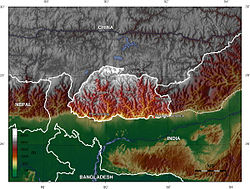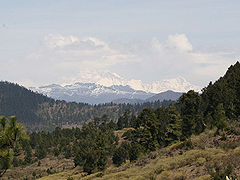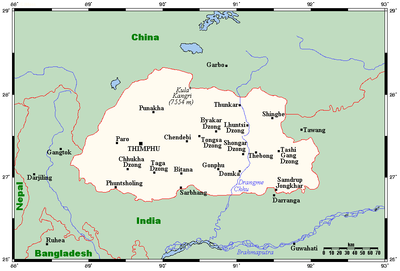Geography of Bhutan
| ||
| Continent | Asia | |
| Subregion | South Asia | |
Geographic coordinates |
27°30′N 90°30′E / 27.500°N 90.500°E | |
| Area - Total - Water |
Ranked 137th 38,394 km2 (14,824.0 sq mi) 0 km2 (0 sq mi) (landlocked) | |
| Coastline | 0 km (0 mi) | |
| Land boundaries | 1,136 km (706 mi) | |
| Countries bordered | China 477 km (296 mi), India 659 km (409 mi) | |
| Highest point | Gangkhar Puensum, 7,570 m (24,836 ft) [1] | |
| Lowest point | Drangme Chhu, 97 m (318 ft) [1]
| |
| Longest river | ||
| Largest inland body of water | ||
| Land Use - Arable land - Permanent crops - Other |
2.62% 0.34% 97.27% (2012 est.) | |
| Irrigated Land | 319.1 km2 (123.2 sq mi) (2010) | |
| Climate: | Varies; tropical in southern plains; cool winters and hot summers in central valleys; severe winters and cool summers in Himalayas | |
| Natural resources | timber, hydropower, gypsum, calcium carbonate
| |
| Natural hazards | Violent storms from the Himalayas are the source of the country's name, which translates as Land of the Thunder Dragon; frequent landslides during the rainy season | |
| Environmental issues | soil erosion; limited access to potable water | |

Bhutan is a very compact landlocked nation, but with just a small bit more
Political geography
Bhutan is divided into 20
Physical geography

The
Below the rock and ice of the highest peaks lies an extensive arc of Eastern Himalayan alpine shrub and meadows, which contain, in additions to grasslands, a wide variety of rhododendrons and herbaceous plants.
The highlands are the most populous part of the nation; the
The
The extreme southern strip of the nation consists mostly of
Centuries of
Strategic location
Bhutan, situated between India and China, is a potential
The second reason comes from the aggression against Tibet by China from 1949 to 1959; the Tibetans have strong cultural, historical, and religious connections to Bhutan.
Bhutan controls several strategic mountain passes through the Himalayas, allowing travel between Tibet and Assam. These passes are also the only way into the kingdom, and, coupled with its centuries-old policies of isolationism, it has been called the "Mountain Fortress of the Gods." The heartland of Bhutan has never been successfully invaded; the British, while establishing a protectorate over the nation, did so with threats to the low-lying territories below the highlands.
Climate

Bhutan's climate is as varied as its altitudes and, like India's, is affected by monsoons. Western Bhutan is particularly affected by monsoons that bring between 60 and 90 per cent of the region's rainfall. The climate is humid and subtropical in the southern plains and foothills, temperate in the inner Himalayan valleys of the southern and central regions, and cold in the north, with year-round snow on the main Himalayan summits.[2]
Temperatures vary according to elevation. Temperatures in Thimphu, located at 2,200 metres (7,218 ft) above sea level in west-central Bhutan, range from approximately 15 to 26 °C (59.0 to 78.8 °F) during the monsoon season of June through September but drop to between about −4 and 16 °C (24.8 and 60.8 °F) in January. Most of the central portion of the country experiences a cool, temperate climate year-round. In the south, a hot, humid climate helps maintain a fairly even temperature range of between 15 and 30 °C (59 and 86 °F) year-round, although temperatures sometimes reach 40 °C (104 °F) in the valleys during the summer.[2]
Annual precipitation ranges widely in various parts of the country. In the severe climate of the north, there is only about 40 millimetres (1.6 in) of annual precipitation—primarily snow. In the temperate central regions, a yearly average of around 1,000 millimetres (39.4 in) is more common, and 7,800 millimetres (307.1 in) per year has been registered at some locations in the humid, subtropical south, ensuring the thick tropical forest, or savanna. Thimphu experiences dry winter months (December through February) and almost no precipitation until March, when rainfall averages 20 millimetres (0.79 in) a month and increases steadily thereafter to a high of 220 millimetres (8.7 in) in August for a total annual rainfall of nearly 650 millimetres (25.6 in).[2]
Bhutan's generally dry spring starts in early March and lasts until mid-April. Summer weather commences in mid-April with occasional showers and continues through the pre-monsoon rains of late June. The summer monsoon lasts from late June through late September with heavy rains from the southwest. The monsoon weather, blocked from its northward progress by the Himalayas, brings heavy rains, high humidity, flash floods and landslides, and numerous misty, overcast days. Autumn, from late September or early October to late November, follows the rainy season. It is characterised by bright, sunny days and some early snowfalls at higher elevations. From late November until March, winter sets in, with frost throughout much of the country and snowfall common above elevations of 3,000 metres (9,843 ft). The winter northeast monsoon brings gale-force winds down through high mountain passes.[2]
| Climate data for Thimphu-Simtokha (1996-2017) | |||||||||||||
|---|---|---|---|---|---|---|---|---|---|---|---|---|---|
| Month | Jan | Feb | Mar | Apr | May | Jun | Jul | Aug | Sep | Oct | Nov | Dec | Year |
| Record high °C (°F) | 24.0 (75.2) |
25.0 (77.0) |
28.0 (82.4) |
30.0 (86.0) |
32.2 (90.0) |
32.0 (89.6) |
33.0 (91.4) |
32.5 (90.5) |
31.0 (87.8) |
31.0 (87.8) |
27.0 (80.6) |
24.0 (75.2) |
33.0 (91.4) |
| Mean daily maximum °C (°F) | 14.8 (58.6) |
16.6 (61.9) |
19.3 (66.7) |
22.4 (72.3) |
24.8 (76.6) |
26.7 (80.1) |
27.0 (80.6) |
27.3 (81.1) |
26.0 (78.8) |
23.7 (74.7) |
19.7 (67.5) |
16.6 (61.9) |
22.1 (71.7) |
| Daily mean °C (°F) | 6.3 (43.3) |
8.5 (47.3) |
11.6 (52.9) |
15.1 (59.2) |
18.2 (64.8) |
21.0 (69.8) |
21.8 (71.2) |
21.7 (71.1) |
20.3 (68.5) |
16.3 (61.3) |
11.5 (52.7) |
7.9 (46.2) |
15.0 (59.0) |
| Mean daily minimum °C (°F) | −2.2 (28.0) |
0.3 (32.5) |
3.8 (38.8) |
7.9 (46.2) |
11.6 (52.9) |
15.3 (59.5) |
16.5 (61.7) |
16.1 (61.0) |
14.6 (58.3) |
9.0 (48.2) |
3.2 (37.8) |
−0.8 (30.6) |
8.0 (46.4) |
| Record low °C (°F) | −8.5 (16.7) |
−7.0 (19.4) |
−7.0 (19.4) |
−2.0 (28.4) |
2.5 (36.5) |
8.0 (46.4) |
11.0 (51.8) |
9.0 (48.2) |
6.0 (42.8) |
−3.0 (26.6) |
−6.0 (21.2) |
−7.5 (18.5) |
−8.5 (16.7) |
| Average rainfall mm (inches) | 6.3 (0.25) |
9.2 (0.36) |
20.4 (0.80) |
29.9 (1.18) |
49.8 (1.96) |
97.7 (3.85) |
152.8 (6.02) |
120.8 (4.76) |
73.9 (2.91) |
43.1 (1.70) |
1.2 (0.05) |
3.7 (0.15) |
608.9 (23.97) |
| Average relative humidity (%)
|
68.6 | 62.6 | 62.8 | 60.2 | 63.2 | 67.0 | 72.7 | 72.2 | 71.2 | 66.6 | 62.1 | 64.0 | 66.1 |
| Source: National Center for Hydrology and Meteorology[3] | |||||||||||||
| Climate data for Phuntsholing (1996-2017) | |||||||||||||
|---|---|---|---|---|---|---|---|---|---|---|---|---|---|
| Month | Jan | Feb | Mar | Apr | May | Jun | Jul | Aug | Sep | Oct | Nov | Dec | Year |
| Record high °C (°F) | 33.0 (91.4) |
33.8 (92.8) |
38.0 (100.4) |
37.0 (98.6) |
39.0 (102.2) |
38.0 (100.4) |
39.0 (102.2) |
40.0 (104.0) |
39.0 (102.2) |
38.0 (100.4) |
36.9 (98.4) |
35.0 (95.0) |
40.0 (104.0) |
| Mean daily maximum °C (°F) | 23.9 (75.0) |
26.6 (79.9) |
29.8 (85.6) |
31.1 (88.0) |
32.3 (90.1) |
32.3 (90.1) |
31.9 (89.4) |
32.3 (90.1) |
31.7 (89.1) |
31.2 (88.2) |
28.7 (83.7) |
25.4 (77.7) |
29.8 (85.6) |
| Daily mean °C (°F) | 18.6 (65.5) |
21.5 (70.7) |
24.2 (75.6) |
25.6 (78.1) |
27.0 (80.6) |
27.7 (81.9) |
27.8 (82.0) |
28.1 (82.6) |
27.4 (81.3) |
26.2 (79.2) |
23.3 (73.9) |
20.2 (68.4) |
24.8 (76.6) |
| Mean daily minimum °C (°F) | 13.4 (56.1) |
16.3 (61.3) |
18.5 (65.3) |
20.1 (68.2) |
21.7 (71.1) |
23.1 (73.6) |
23.7 (74.7) |
23.8 (74.8) |
23.1 (73.6) |
21.1 (70.0) |
17.9 (64.2) |
15.0 (59.0) |
19.8 (67.7) |
| Record low °C (°F) | 5.0 (41.0) |
9.0 (48.2) |
12.0 (53.6) |
14.3 (57.7) |
15.1 (59.2) |
16.0 (60.8) |
17.0 (62.6) |
19.0 (66.2) |
17.0 (62.6) |
14.0 (57.2) |
10.0 (50.0) |
7.5 (45.5) |
5.0 (41.0) |
| Average rainfall mm (inches) | 17.3 (0.68) |
31.1 (1.22) |
80.2 (3.16) |
216.5 (8.52) |
380.3 (14.97) |
807.2 (31.78) |
962.6 (37.90) |
779.1 (30.67) |
492.6 (19.39) |
162.9 (6.41) |
13.2 (0.52) |
10.4 (0.41) |
3,953.4 (155.63) |
| Average relative humidity (%)
|
72.4 | 71.3 | 70.0 | 74.7 | 80.1 | 83.8 | 88.5 | 87.1 | 84.4 | 75.6 | 70.7 | 72.4 | 77.6 |
| Source: National Center for Hydrology and Meteorology[4] | |||||||||||||
Glaciers
Glaciers in northern Bhutan, which covered about 10 per cent of the total surface area in the 1980s, are an important renewable source of water for Bhutan's rivers. Fed by fresh snow each winter and slow melting in the summer, the glaciers bring millions of litres of fresh water to Bhutan and downriver areas each year. Glacial melt adds to monsoon-swollen rivers, however, also contributes to flooding. Where glacial movement temporary blocks riverflows, downstream areas may be threatened by glacial lake outburst floods (GLOFs), also called jökulhlaups.[5]
Bhutan's glaciers are melting. A 2008 United Nations report suggested that due to rising temperatures, glaciers in Bhutan were retreating at a rate of 30–40 metres (100–130 ft) per year, poised to make many lakes burst their banks and send millions of gallons of floodwater downstream. This among many other climate-related issues identified in the report prompted the regional association of government ministers to establish the Southeast Asia Regional Health Emergency Fund in Thimphu in September 2007.[6] Similarly, the member nations of South Asian Association for Regional Cooperation (SAARC) adopted bilateral agreements including measures on climate change and glaciers at its summit in April 2010.[7]
The 2008 UN report also indicated Himalayan glaciers would melt within 25 years,
The new inventory "Bhutan Glacial Inventory 2018" includes 700 glaciers covering total area of 629.55 ± 0.02 km2 (243.0706 ± 0.0077 sq mi) in the northern frontiers of Bhutan. Glacier area covers 1.64% of the total land cover in Bhutan.[10]
Lakes
Bhutan is home to at least 59 natural mountain lakes as well as some 2,674
Non-glacial lakes in Bhutan cover a total of about 4,250 hectares (16.4 sq mi). Most are located above an altitude of 3,500 metres (11,500 ft), and most have no permanent human settlements nearby, though many are used for grazing yaks and may have scattered temporary settlements.[12][13]
River systems

Bhutan has four major river systems: the
Valleys
References
- ^ World Factbook. CIA. 22 March 2011. Retrieved 3 April 2011.
- ^ a b c d
 This article incorporates text from this source, which is in the public domain. Robert L. Worden (September 1991). Andrea Matles Savada (ed.). Bhutan: A Country Study. Federal Research Division. Climate.
This article incorporates text from this source, which is in the public domain. Robert L. Worden (September 1991). Andrea Matles Savada (ed.). Bhutan: A Country Study. Federal Research Division. Climate.
- ^ "Climate Data Book of Bhutan, 2018" (PDF). National Center for Hydrology and Meteorology. Retrieved 13 July 2021.
- ^ "Climate Data Book of Bhutan, 2018" (PDF). National Center for Hydrology and Meteorology. Retrieved 13 July 2021.
- ^
 This article incorporates text from this source, which is in the public domain. Robert L. Worden (September 1991). Andrea Matles Savada (ed.). Bhutan: A Country Study. Federal Research Division. Glaciers.
This article incorporates text from this source, which is in the public domain. Robert L. Worden (September 1991). Andrea Matles Savada (ed.). Bhutan: A Country Study. Federal Research Division. Glaciers.
- ^ a b Tirwa, Badan (19 January 2008). "Managing health disaster". Thimphu: Bhutan Observer online. Archived from the original on 20 January 2011. Retrieved 27 March 2011.
- ^ Pelden, Sonam (10 April 2010). "Summit declaration ready for adoption". Bhutan Observer online. Archived from the original on 20 January 2011. Retrieved 27 March 2011.
- ^ Tshering, Namgay (29 January 2011). "Himalayan glaciers not retreating, says new report". Bhutan Observer online. Archived from the original on 7 February 2011. Retrieved 27 March 2011.
- ^ Pelden, Sonam (2 April 2010). "Looking beyond hydropower". Bhutan Observer online. Archived from the original on 3 October 2011. Retrieved 27 March 2011.
- ^ "National Center for Hydrology and Meteorology". nchm.gov.bt. Retrieved 28 July 2019.
- ^ Pelden, Sonam (3 September 2010). "Thorthormi water level brought down 43 cm". Bhutan Observer online. Archived from the original on 19 January 2011. Retrieved 27 March 2011.
- ISBN 978-81-8324-265-3.
- ^ "Survey of the Waters of Bhutan – Physiography and Fisheries Potential". United Nations Food and Agriculture Organization. December 1978. Retrieved 26 November 2011.
- ^
 This article incorporates text from this source, which is in the public domain. Robert L. Worden (September 1991). Andrea Matles Savada (ed.). Bhutan: A Country Study. Federal Research Division. River Systems.
This article incorporates text from this source, which is in the public domain. Robert L. Worden (September 1991). Andrea Matles Savada (ed.). Bhutan: A Country Study. Federal Research Division. River Systems.
- ^ a b
 This article incorporates text from this source, which is in the public domain. Worden, Robert L. (1991). Savada, Andrea Matles (ed.). Bhutan: A Country Study. Federal Research Division. The Land.
This article incorporates text from this source, which is in the public domain. Worden, Robert L. (1991). Savada, Andrea Matles (ed.). Bhutan: A Country Study. Federal Research Division. The Land.
- ^
 This article incorporates text from this source, which is in the public domain. Worden, Robert L. (1991). Savada, Andrea Matles (ed.). Bhutan: A Country Study. Federal Research Division. Population – Size, Structure, and Settlement Patterns.
This article incorporates text from this source, which is in the public domain. Worden, Robert L. (1991). Savada, Andrea Matles (ed.). Bhutan: A Country Study. Federal Research Division. Population – Size, Structure, and Settlement Patterns.
- ^ White, John Claude (1909). Sikhim & Bhutan: Twenty-One Years on the North-East Frontier, 1887-1908. E. Arnold. pp. 3–6. Retrieved 15 October 2011.
- ISBN 978-1-59311-734-4. Retrieved 10 August 2011.
- )
- ISBN 978-1-74059-529-2. Retrieved 25 November 2011.
- ^
 This article incorporates text from this source, which is in the public domain. Worden, Robert L. (1991). Savada, Andrea Matles (ed.). Bhutan: A Country Study. Federal Research Division. Transportation and Communications – Roads.
This article incorporates text from this source, which is in the public domain. Worden, Robert L. (1991). Savada, Andrea Matles (ed.). Bhutan: A Country Study. Federal Research Division. Transportation and Communications – Roads.
- ^
 This article incorporates text from this source, which is in the public domain. Worden, Robert L. (1991). Savada, Andrea Matles (ed.). Bhutan: A Country Study. Federal Research Division. River Systems.
This article incorporates text from this source, which is in the public domain. Worden, Robert L. (1991). Savada, Andrea Matles (ed.). Bhutan: A Country Study. Federal Research Division. River Systems.
- ISBN 81-7835-194-3. Retrieved 15 October 2011.
- ISBN 978-1-74059-529-2. Archived from the original(PDF) on 7 June 2011. Retrieved 15 October 2011.

